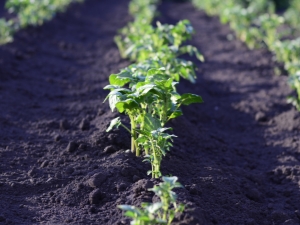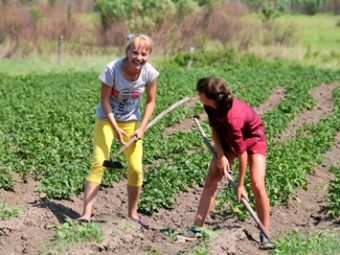How many days after planting does a potato sprout and what does it depend on?

One of the main foodstuffs for both the city dweller and the villager has been potato for many years. Unpretentious culture is quite simple to maintain and is easily stored during the winter cold. It is planted, as a rule, in May, however, preparing and planting potatoes is only half the battle. In order for the seeds to give good seedlings and a rich harvest, many factors must be taken into account, ranging from potato varieties and the average temperature in the region to soil moisture and planting rules.
Timing
The planting of an early vegetable begins at the beginning or in the middle of May, when the air temperature is at around 10 degrees. Of course, you can monitor temperature changes daily to catch the right moment, but you can turn to long-term observations of experienced gardeners. One of the first signs of a ready soil for planting potatoes is the appearance of earthworms in it. You can also pay attention to the birch leaves: if they are commensurate with a ruble coin, then it's time to plant. Late varieties of potatoes are planted at a temperature of 10-15 degrees, when dandelions begin to bloom.
The first shoots usually appear 20–25 days after planting, the ground should be at least 10 degrees in temperature. If the weather is warm and the soil temperature has reached 20 degrees, the potatoes sprout in 10-15 days. Also, the humidity of the environment significantly affects the germination: the more moisture in the soil, the less time is needed for the first tops to appear. Even greater speed is achieved in the absence in the soil of a large amount of salts and the introduction of additional humus and various fertilizers into it.
It is considered the most correct to plant germinated tubers. To do this, you must in advance (at the beginning or mid-April) put the vegetables in wooden boxes and put them in a warm place with good lighting. After 1-2 weeks, white shoots will appear on almost all tubers.
Peat or wet sawdust, poured into the same box between the tubers, will speed up the process. Also, starting from April, you can not throw out the potatoes sprouted in the pantry or cellar, but put it away for later planting.
Temperature readings
Undoubtedly, the right temperature is the main condition for a good harvest of both an experienced gardener and a beginner. Nevertheless, growing potatoes in a greenhouse, like other vegetables, is impractical: the crop can only be harvested once, and the area sown for this should be maximum. Therefore it is necessary to adapt to the weather conditions of the region where the process of cultivation of the culture takes place.
- In the more southern regions of the country, it grows faster and produces smaller fruits. In addition, you have to water it often enough to protect it from drying out.
- In the northern regions, shoots appear much later, but if the weather spoils with heat and sun, then the size of each tuber favorably differs to a greater extent.
To just start growing, potatoes need a minimum soil temperature of about 10 degrees. In colder soil, root growth stops, the root pressure inside the plant decreases, and the juice flow through it slows down. Many seedlings can freeze or be eaten by worms and bears. If the planting of potatoes is scheduled for a certain day, and the earth has not warmed up by that moment, you need to plant it at a shallow depth. You should not dig large pits - a small hole of 5–6 cm is enough. If you can wait for the soil to warm up completely, you can dig a hole 10–12 cm deep.
Do not start planting vegetables on the first warm day after the snow melts. The fact is that even the most loose soil warms up much longer than air. The northern regions need about 2 months for this, and in the southern terrain such a process takes about 3-5 weeks.
Depending on the variety
At least temperature is important selected potato variety.For planting in the middle lane most often choose mid-early and early varieties, as they are better tolerate temperature fluctuations and night frosts. Hybrids such as Laguna F1, Tushon or Zabava F1 can easily be picked by any gardener, even if they were planted in mid-April. Despite the fact that the average germination of potatoes is about a month, there are varieties that can be eaten within 1.5 months after planting: early and ultra-early potatoes.
After selecting the variety, it is necessary to select the correct tubers for planting from the available seed potatoes. The seed must have the following characteristics:
- tuber firm and strong;
- whole potatoes are about the same size;
- there is no rot on seed potatoes, damages from insects and animals;
- in the tubers in the plural there are short thick sprouts ("eyes").
Experienced gardeners select tubers the size of a large chicken egg, on which there is no visible damage. The presence of rot will not allow the bush to develop properly, and a tuber “eaten away” by insects may not produce a crop at all. The potato should have a lot of eyes, of which the first shoots will appear.
Landing rules
Before proceeding directly to planting potatoes, it is necessary to conduct additional training, which includes several important steps.
Plot
For a good harvest, nutrient soil is needed, so when digging the site in autumn you can add various fertilizers in the form of peat or humus to it. They are added in small quantities: just one bucket is enough for an area of 1 sq. M. In spring, the land is carefully plowed, and all vegetation is removed from it. In addition, the place for planting potatoes should be well lit by the sun, as this vegetable grows very reluctantly in the shade. You should not plant potatoes in the same place for more than two years in a row. The soil should either rest, or something else should be planted on it, but not solanaceous. It is best for crop rotation suitable legumes, zucchini or garlic.
7–10 days before landing in the ground, you need to add sand to the structure of the soil was more loose.
If there is a need for additional fertilizer, you can add 1–2 tablespoons of superphosphate to the holes dug in advance and cover the entire dug surface with polyethylene.
Material preparation
In the autumn you need to start preparing for the next landing. Seed tubers are taken from the harvested crop and placed under scattered sunlight for several days. Green seeds are stored in fabric bags or wooden boxes separately from the crop intended for food. In the spring, the potatoes are sorted and sorted out again, ruthlessly getting rid of any damaged tubers. The selected material is laid out in one or two layers on a tree (in boxes or on racks) in a bright room with an air temperature of 15 degrees and above. If everything was done correctly, after three weeks the first shoots should appear on the roots. Before planting, another culling is carried out, in which all non-germinated potatoes are harvested, leaving only the tubers with the correct roots.
In the case when there is no time and opportunity to germinate vegetables, it is enough to warm them after long storage in cold. To do this, leave the potatoes in a dark, but warm (at least 18 degrees) place for 10 days, and then conduct the final culling.
At the same stage, it is possible to conduct primary protection against pests and diseases by soaking the potatoes in a special chemical solution or spraying it. To do this, use insectofungicides "Prestige" or "Maxim" and growth stimulants "Epin" or "Vermistim". As a result of this treatment, potatoes grow faster and more secure.
Landing
The most favorable crop planting scheme is 80x35 and with a depth of not more than 10 cm.More frequent planting will not allow the root system to develop properly and may increase the risk of potato blight. After the first shoots rise and rise no less than 10 cm in height, the first hilling can be performed. The soil near the hole is going to hoe, and the plant gently powdered.
The second hilling is usually carried out when the height of the tops reaches 35–40 cm. At the same time, the entire area of planting is carefully weeded and mulched.
Causes of uneven shoots
If a potato is planted not for the first time, then most often there is no problem with the speed of its ripening. However, novice gardeners may allow many missteps, so that the seeds will germinate unevenly. There may be several reasons for this.
- Different depth of holes. Since the soil is heated unevenly, a drop of even a few centimeters may result in a delay in the growth of tops.
- Different size of seed potatoes. For the germination of large tubers requires more time than for tubers of medium and small size.
- Different varieties of potatoes. There are more precocious and less precocious vegetables, so the time of appearance of the first shoots is very different.
- Seed potatoes were unevenly germinated. Potatoes with a large number of eyes germinate much faster than those with only 2-3 eyes.
Sometimes it happens that all the conditions for proper preparation and planting of potatoes are met, and the germs have not appeared. This may be due to the fact that the seeds were stored in closed bags of polyethylene, and its germination has come to zero.
You should never use synthetic closed containers for seed storage: this will negate all the efforts of the landlord.
In general, the special tricks of growing potatoes do not exist. Like any crop, it needs to be fertilized, loosened and weeded in a timely manner. Wait for the first shoots should be no more than 1.5 months. If during this time the green leaves did not even appear above the surface of the earth, they will not. The reasons can be either the poor quality of seed potatoes or the disease of already planted tubers. In the next landing it is worth considering all previous mistakes and then you can get excellent harvest.
Secrets of planting potatoes, see the following video.
































